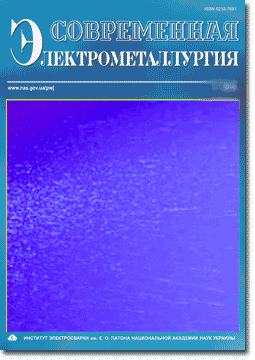

ELECTROSLAG TECHNOLOGY
Sokolov V. M., Babyuk V. D., Zhidkov E. A., Shinsky I. O. Producing of small batches of castings from a nickel-base heat-resistant alloy using the ESCM process
Problems of combination of processes of electroslag crucible melting (ESCM) and casting by gasifiable models (CGM) are considered. This technology is based on remelting metallic scrap using a molten flux, which is poured out and the metal is poured into container with a block of models, being under vacuum. The offered technology is effective both for a single-batch and mass production of castings. When necessary to increase the rate of solidification of castings it is recommended to use the new GAMODAR-process, during which the metal pouring and casting solidification are realized under the controllable pressure conditions. The technology is used in production of heat-resistant alloy components. The feasibility of effective combination of ESCM processes and different casting technologies was proved. The CGM is ecologically protected by a special system of purification of exhausting gases and sand. P. 3 Okhotsky V. B. Removal of non-metallic inclusions in electroslag remelting
Models of coalescence of liquid phases at wave and viscous conditions of the melt motion have been developed. Data, calculated from the models, are correlated with experimental results. It is shown that the coalescence of non-metallic inclusions is most probable at their low viscosity. Model of Handlos-Baron describes appropriately the removal of non-metallic inclusions from the metal drops during electroslag remelting. P. 7 ELECTRON BEAM PROCESSES
Movchan B. A., Yakovchuk K. Yu. New approach to producing microporous materials and coatings by electron beam evaporation of inorganic substances
The features of the EB-PVD microporous materials and coating forming were studied. The original method for its producing by EB-PVD of non-organic materials in vacuum was proposed. The mechanism of microporous structure forming is considered. The results of microstructure investigations of the microporous ZrO2-Y2O3, Al2O3 and NiCoCrAlY condensates and coatings with NaCl additions are presented. P. 11 Kalinyuk A. N., Zhuk G. V., Trigub N. P. Determination of depth of shrinkage cavity bedding in ingots of EBRIC of titanium alloy Ti-6Al-4V
Results of theoretical and experimental investigations of the process of formation of a shrinkage cavity in ingots of titanium alloy Ti-6Al-4V in electron beam melting with an intermediate crucible are given. The fields of temperatures in ingots at a quasi-stationary condition of melting and solidification of the last zone of the solid-liquid phase are obtained. Depth of localization and sizes of the shrinkage cavities in round-section ingots of 200, 300 and 400 mm diameters at an instantaneous disconnection of the heat source and a gradual reducing of power are defined. P. 14 Lesnoy A. B., Demchenko V. F., Zhadkevich M. L. Modelling of hydrodynamics and heat exchange in solidication of electron beam remelted ingots
Conjugate model of heat exchange and hydrodynamics in solidification of the electron beam remelted (EBR) ingot is considered. The model is based on the equation of a convective-conductive transfer of energy and a full system of Navier-Stokes equations with allowance for a thermogravitational, thermocapillary and forced convection which is caused by a metal pouring from the intermediate crucible. Heat and hydrodynamic situation in a solidifying EBR cylindrical ingot was analyzed using the methods of a computer modelling. P. 17 PLASMA-ARC TECHNOLOGY
Latash Yu. V., Burnashev V. R., Torkhov G. F., Likhobaba A. V. Peculiarities of producing chromium ingots by the method of plasma arc remelting
Technology of melting slab chromium billets by the method of a plasma-arc remelting (PAR) has been developed. The following plates were produced: 18...24 mm thickness, 90...100 mm width and 100...800
The effect of a plasma surface treatment on the structures and service properties of sparsely-alloyed deposited metal was examined. For all the examined compositions within the ranges of alloying by a carbon equivalent Cequiv = 0.8...2.1 % the zone of plasma hardening has a high-dispersed martensitic-carbide structure, increased hardness and dynamic crack resistance as compared with the initial state. In addition, with increase in a carbon equivalent both in initial and hardened state the hardness of the deposited metal is increased and the crack resistance is decreasd. P. 26 GENERAL PROBLEMS OF METALLURGY
Grigorenko G. M., Pomarin Yu. M., Orlovsky V. Yu. Kinetics of nitrogen interaction with liquid zirconium and titanium
Kinetic relationships of nitrogen absorption by liquid zirconium and titanium from the gas phase are presented. The interaction reactions were studied by the method of melting in a suspended state within the wide interval of temperatures and partial pressures of nitrogen. It is shown that the reactions are proceeding till the formation of nitrides of the given metals, gas concentration in metal is described by the second-order equation and the limiting stage of the process is a chemical-adsorption link. P. 32 Zelensky V. F., Neklyudov I. M., Lapshin V. I., Sheiko I. V., Kobyako I. P., Nademsky V. A., Atramentov V. A., Zeidlitz M. P., Klinchuk Yu. I., Cherniy B. P. Production of industrial goods in Ukraine from scrap of platinum and alloys on its base (Recycling and refining of scrap)
Technological process of extraction, preparation and purification of scrap from the industrial waste of platinum and alloys on its base at the state research-production enterprise of the vacuum metallurgy of structural materials "Rubin" (Kharkov city) is described. It is shown that the developed process provides the minimum losses of noble metals in refining of scrap and producing noble metals containing not more than 1x10-3 mass % of each impurity of ignoble metals. The technologies and equipment are characterized by a good ecology of the processes and low expenses. P. 38 REVIEW AND SCIENTIFIC DISCUSSIONS
Khokhlov A. A. Letter to the Editorial board concerning the remarks of V. I. Lakomsky to the article of Khokhlov A. A. "Investigation of nitrogen interaction with molten steel in plasma melting", published in journal "Problemy Spetsialnoy Elektrometallurgii". - 2000. - No. 1. P. 44
Lakomsky V. I. Brief reply to the Editorial board of the journal "Problemy Spetsialnoy Elektrometallurgii" concerning the A. A. Khokhlov's letter. P. 45
INFORMATION
Tsykulenko A. K. International Symposium devoted to the memory of academician Medovar B. I. P. 47
In memory of Trefilov Viktor Ivanovich P. 51
Calendar of International and national events on electrometallurgy and related technologies for the second half-year of 2001. P. 52
Advertising. P. 54
(You are viewing the simplified file contents)
The cost of subscription/purchase order journals or individual articles
| Journal/Currency | Annual Set | 1 issue printed |
1 issue |
one article |
| TPWJ/USD | 384 $ | 32 $ | 26 $ | 13 $ |
| TPWJ/EUR | 348 € | 29 € | 24 € | 12 € |
| TPWJ/UAH | 7200 UAH | 600 UAH | 600 UAH | 280 UAH |
| AS/UAH | 1800 UAH | 300 UAH | 300 UAH | 150 UAH |
| AS/USD | 192 $ | 32 $ | 26 $ | 13 $ |
| AS/EUR | 180 € | 30 € | 25 € | 12 € |
| SEM/UAH | 1200 UAH | 300 UAH | 300 UAH | 150 UAH |
| SEM/USD | 128 $ | 32 $ | 26 $ | 13 $ |
| SEM/EUR | 120 € | 30 € | 25 € | 12 € |
| TDNK/UAH | 1200 UAH | 300 UAH | 300 UAH | 150 UAH |
| TDNK/USD | 128 $ | 32 $ | 26 $ | 13 $ |
| TDNK/EUR | 120 € | 30 € | 25 € | 15 € |
AS = «Automatic Welding» - 6 issues per year;
TPWJ = «PATON WELDING JOURNAL» - 12 issues per year;
SEM = «Electrometallurgy Today» - 4 issues per year;
TDNK = «Technical Diagnostics and Non-Destructive Testing» - 4 issues per year.





